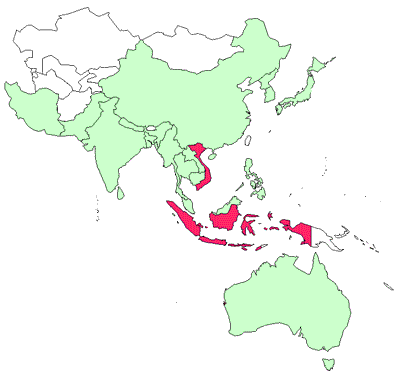Diseases of finfish
Bacterial diseases—Enteric septicaemia of catfish
CLICK ON IMAGE TO ENLARGE

Source: L Hanson
CLICK ON IMAGE TO ENLARGE

Source: L Hanson
CLICK ON IMAGE TO ENLARGE

Source: L Hanson
Signs of disease
Important: animals with disease may show one or more of the signs below, but disease may still be present in the absence of any signs.
Disease signs at the tank and pond level
- lethargy
- lack of appetite
- disorientation and fish swimming in spirals
- 'surfing', with head protruding from water
Clinical signs of disease in an infected animal
- pale gills
- darkening of skin
- multiple small white spots on skin
- raised skin patches progressing to shallow ulcers on flanks and head
- ascites (swollen abdomen from accumulated fluid)
- haemorrhage at the base of fins, or around the head, operculum (gill cover) and abdomen
- exophthalmus (pop eye)
Gross signs of disease in an infected animal
- large bloody spots on the liver
- fluid in the abdominal cavity and intestine frequently bloody, but may be transparent or clear yellow
- spleen, anterior kidney or posterior kidney may be soft and pale with pinpoint haemorrhages
Disease agent
The condition is caused by the bacterium Edwardsiella ictaluri.
Host range
Enteric septicaemia of catfish is a highly infectious bacterial disease of catfish, especially ictalurids.
black bullhead* (Ictalurus melas)
blue catfish* (Ictalurus furcatus)
brown bullhead* (Ictalurus nebulosus)
channel catfish* (Ictalurus punctatus)
glass knife fish* (Eigenmannia virescens)
rosy barb* (Puntius conchonus)
sind danio* (Danio devario)
sutchi catfish* (Pangasius hypophthalmus)
walking catfish* (Clarias batrachus)
white catfish* (Ictalurus catus)
yellow bullhead* (Ictalurus natalis)
zebra fish danio* (Danio rerio)
chinook salmon (Oncorhynchus tshawytscha)
rainbow trout (Oncorhynchus mykiss)
* naturally susceptible (other species have been shown to be experimentally susceptible)
Presence in Asia–Pacific

ESC has been officially reported from Indonesia and Vietnam.
Epidemiology
- The bacterium can survive 3–4 months in pond water, mud and vegetation.
- Morbidity and mortality can be high in heavily stocked ponds.
- Horizontal transmission is via the faecal–oral route, cannibalism, and contact with contaminated water and materials used in handling.
- The intestinal tract is the primary site of infection.
- Faeces are the main source of shedding and dissemination, although dead fish and equipment such as fishing nets and sorting devices may be involved in contamination.
- Surviving catfish carry the bacterium, which also seems to be able to survive in the intestinal tracts of other fish species.
- Disease occurs primarily at water temperatures between 18°C and 28°C. Stress is often a predisposing factor.
- Environmental stressors can influence expression of clinical signs and extend the incubation period.
Differential diagnosis
The differential diagnostic table and the list of similar diseases appearing at the bottom of each disease page refer only to the diseases covered by this field guide. Gross signs observed might well be representative of a wider range of diseases not included here. Therefore, these diagnostic aids should not be read as a guide to a definitive diagnosis, but rather as a tool to help identify the listed diseases that most closely account for the gross signs.
Similar diseases
Sample collection
Because of uncertainty in differentiating diseases using only gross signs, and because some aquatic animal disease agents might pose a risk to humans, you should not try to collect samples unless you have been trained. Instead, you should phone your national hotline number and report your observations. If samples have to be collected, the agency taking the call will advise you on what you need to do. Local or district fisheries/veterinary authorities could advise you on sampling.
Emergency disease hotline
For your national emergency disease hotline number, see Whom to contact if you suspect a disease.
Further reading
http://www.oie.int/aac/eng/cards/en_diseasecard.htm
The currently accepted procedures for a conclusive diagnosis of ESC are summarised at http://www.oie.int/eng/normes/fmanual/A_00029.htm
These hyperlinks were correct and functioning at the time of publication.

